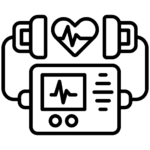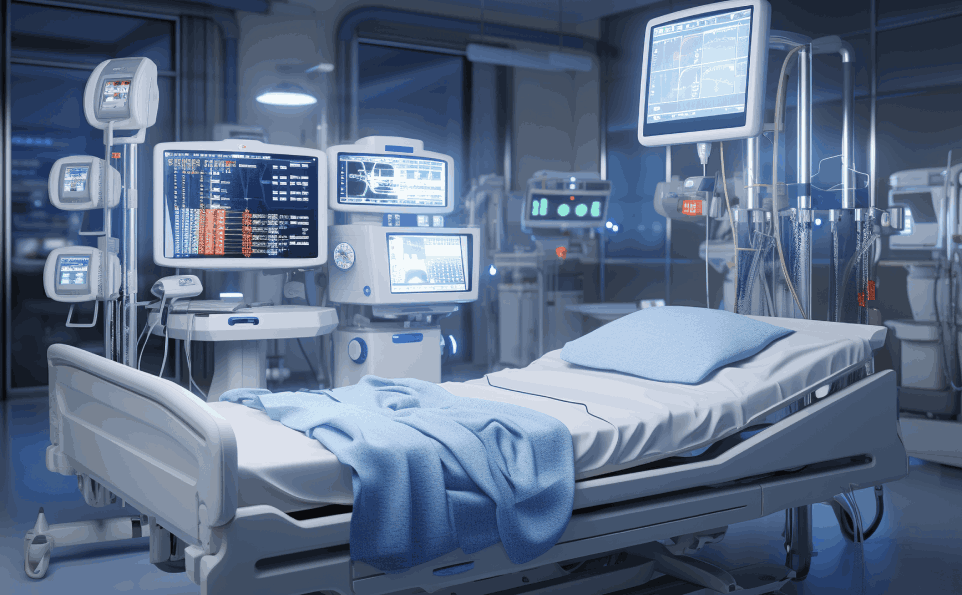For years, hospital beds have been a familiar sight, offering basic comfort and support. While they’ve been important for patient care, they haven’t kept pace with modern healthcare needs. But things are changing! New “high-tech” bed prototypes are emerging, and they’re set to revolutionize how we care for patients by turning these simple beds into powerful tools for better comfort, monitoring, and personalized treatment.
Smarter Beds, Better Care
Imagine a hospital bed that’s more than just a place to lie down. These high-tech beds are packed with features that can:
Keep a Close Eye
Built-in sensors can constantly track important things like heart rate, blood pressure, oxygen levels, and even sleep patterns. This real-time information helps doctors spot problems early and take action quickly, improving patient outcomes.
Personalized Comfort
Everyone needs different levels of support when they’re not feeling well. High-tech beds can adjust pressure points, automatically change positions for better posture, and even control temperature to prevent bed sores, improve sleep, and speed up recovery.
Stay Connected
These beds aren’t just places to rest; they’re communication hubs. Touchscreens, voice assistants, and internet connections let patients control their environment, access entertainment and information, and easily connect with doctors and loved ones. This gives them more control and keeps them feeling engaged, which can improve their overall well-being.
Predict the Future
The data collected from these smart beds is a treasure trove for personalized and preventative care. Doctors can analyze this information to identify potential health risks before they become problems, allowing for earlier interventions and tailored treatment plans. This shift to data-driven healthcare promises better use of resources and improved patient outcomes overall.
Beyond the Basics
High-tech beds go beyond just monitoring and comfort. Here are some additional features that can make a big difference in patient care:
Fall Prevention
Imagine a bed that acts like a guardian angel. Built-in sensors can detect when someone tries to get out of bed without assistance. This triggers an alarm or even gently lowers the bed to prevent falls and potential injuries, especially important for patients who are at risk.
Wound Care Helpers
Pressure sores, also known as bedsores, can be a serious concern for patients who are bedridden for long periods. Special mattresses and surfaces in high-tech beds can help manage these sores by:
Redistributing pressure
These surfaces adjust and conform to the body’s shape, reducing pressure points that can lead to skin breakdown.
Microclimate control
Some beds have built-in temperature and moisture regulation features that help keep the skin dry and prevent infection, promoting faster healing.
Mood Lighting
Hospitals can be bright and sterile environments, which can affect a patient’s mood and sleep. High-tech beds can adjust the lighting in the surrounding area, creating a more calming and relaxing atmosphere. Think soft, warm tones for sleep and brighter settings for reading or activities.
Medical Device Buddies
These beds can seamlessly connect with other medical equipment like infusion pumps and vital sign monitors. This allows for:
Automatic data collection
Information like medication delivery rates or blood pressure readings are automatically collected and sent to the patient’s electronic medical record, reducing the need for manual checks and improving data accuracy.
Streamlined care
Healthcare professionals can easily access and monitor patient data from a central location, allowing for quicker adjustments and interventions if needed.
Challenges and Hurdles
While these high-tech beds offer amazing possibilities, there are some things to consider before they become widespread:
Cost Matters
Developing and using these advanced beds can be much more expensive than traditional models. Finding cost-effective solutions and integrating them smoothly into existing healthcare systems is crucial.
Data Security
With all this technology comes the concern of keeping patient information safe. Strong data protection measures and clear regulations are essential to ensure privacy and security.
Ethical Concerns
Using AI and advanced technology in healthcare requires careful consideration of ethical implications. Clear guidelines and rules are needed to ensure responsible use, prevent bias, and protect patient autonomy.
Training Time
Healthcare professionals will need proper training to use these high-tech beds effectively and provide the best possible care.
A Glimpse into the Future
The potential impact of high-tech beds on healthcare is undeniable. Ongoing research and development are constantly pushing the boundaries of what these beds can do. From personalized sleep optimization to real-time health monitoring and early intervention, the future of patient care promises to be significantly enhanced by these technological advancements.
Beyond the Bed: A Connected Network
The impact of high-tech beds goes beyond the individual unit, creating a connected healthcare ecosystem. Data collected from these beds can be integrated with electronic medical records, allowing for comprehensive patient monitoring and informed decision-making by healthcare teams. Additionally, advancements in robotics and automation may lead to intelligent bed systems that can assist healthcare professionals with tasks like patient repositioning and transfer, further improving efficiency and safety.
Conclusion
High-tech bed prototypes represent a major shift in healthcare, paving the way for a future where patient care is personalized, data-driven, and proactive. Further research and development, coupled with addressing the existing challenges, will be instrumental in bringing these innovative solutions into mainstream healthcare settings and revolutionizing the way we care for patients. As we move towards a future of intelligent healthcare, the humble hospital bed is poised to become a powerful tool for optimizing patient outcomes and enhancing the overall healthcare experience.
FAQs
High-tech beds are hospital beds equipped with advanced features like sensors, monitoring systems, adjustable settings, and connectivity. They go beyond basic comfort and support, offering personalized care, real-time health monitoring, and improved patient outcomes.
These beds can track vital signs, adjust pressure points for comfort, control temperature, connect to medical devices, and even help prevent falls and manage bed sores. They also offer features like mood lighting and communication tools for a more connected and comfortable experience.
These beds provide personalized care, allowing for early detection of problems, improved sleep quality, faster recovery, and reduced risk of complications like falls and bed sores. They also give patients more control and connection with their environment.
Cost, data security, ethical considerations regarding AI use, and the need for healthcare professional training are some hurdles that need to be addressed before high-tech beds become widely available.
These beds have the potential to revolutionize patient care by enabling personalized, data-driven, and proactive healthcare. They can create a connected healthcare ecosystem, improving patient monitoring, decision-making, and overall healthcare efficiency.
Yes, some high-tech beds have built-in sensors that detect when someone tries to get out of bed without assistance. This triggers an alarm or gently lowers the bed, preventing falls and potential injuries.
Special mattresses and surfaces in these beds can adjust pressure and regulate temperature to prevent bed sores and promote faster healing for patients who are bedridden for long periods.
 Hospital Furniture
Hospital Furniture Medical Devices
Medical Devices MSR Products
MSR Products Office Furniture
Office Furniture